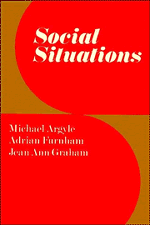Book contents
- Frontmatter
- Contents
- Preface
- 1 Introduction
- 2 The analysis of social situations
- 3 The effect of the situation on behaviour
- 4 Drives and goals
- 5 Rules
- 6 Role-systems
- 7 Repertoire of elements
- 8 Sequences of interaction
- 9 Concepts and cognitive structures
- 10 Environmental setting
- 11 Language and speech
- 12 Stressful situations
- 13 Applications of situational analysis
- 14 Conclusions
- References
- Names index
- Subject index
2 - The analysis of social situations
Published online by Cambridge University Press: 01 June 2011
- Frontmatter
- Contents
- Preface
- 1 Introduction
- 2 The analysis of social situations
- 3 The effect of the situation on behaviour
- 4 Drives and goals
- 5 Rules
- 6 Role-systems
- 7 Repertoire of elements
- 8 Sequences of interaction
- 9 Concepts and cognitive structures
- 10 Environmental setting
- 11 Language and speech
- 12 Stressful situations
- 13 Applications of situational analysis
- 14 Conclusions
- References
- Names index
- Subject index
Summary
Introduction
Perhaps one of the most confused, ambiguous and least researched branches of modern psychology is the social and physical context in which behaviour occurs, and its effects on behaviour. The sterility and unrepresentativeness of the psychology laboratory for research into social behaviour has been well documented (Rosenthal, 1966; Rosenthal and Rosnow, 1969), and the necessity of field work emphasised. Many psychological processes have been studied in situations so far removed from the natural situations in which these behaviours occur that different psychological processes altogether may be operating – hence the poor laboratory studies. Experiments like the Prisoners' Dilemma Game exclude verbal and non verbal communication; there are no obvious rules or other features of the situation and there is no established relationship between the interactors (Argyle, 1969). It has been demonstrated that laboratory experiments can obtain misleading results: Argyle and McHenry (1971) found that wearing spectacles added to perceived IQ only if the person in question did not speak. Psychologists have selected and manipulated one or two elements in the social setting they are studying, and which they expect to influence certain aspects of behaviour (the dependent variable), while attempting to ‘control’ all other relevant variables (Fraisse, 1968). These ‘situational’ variables have ranged from task conditions and mood states to confederator interaction and furniture arrangement, yet the subjects have rarely been consulted afterwards as to how they perceived the ‘situation’ as defined by the experimenter, or to see whether they perceived it in the same way as he did.
- Type
- Chapter
- Information
- Social Situations , pp. 12 - 40Publisher: Cambridge University PressPrint publication year: 1981



